Samsung Galaxy Watch 6 vs. Apple Watch Series 8
Samsung wins for battery, durability, brightness, and memory; Apple pulls ahead for storage, controls, software, and fitness.
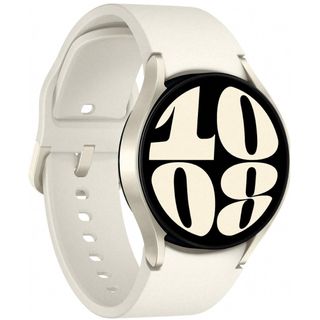
Despite looking nearly identical to the Galaxy Watch 5, the latest Watch 6 added a new processor, more memory, and larger, brighter displays while slimming down a millimeter. Its battery life is shorter than before but still easily beats Apple's. It's just too bad you have to pay extra for the Classic's heavy rotating bezel.
For
- Brighter displays
- Military-grade protection
- Thinner, lighter design
- Twice the RAM
- Longer battery life
Against
- Capacitive touch bezel
- Only 16GB storage
- Fewer fitness tools
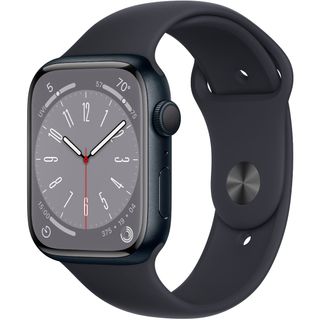
Even though the Series 8 has the Series 7 display and Series 6 processor, the latest Apple Watch is still a bestseller for a reason. It has reliable performance, excellent software support from Apple and third-party devs, and all the health data you could want. Too bad the battery life is just as unreliable as ever.
For
- Rotating crown
- More stylish design
- Double the storage
- Longer software support
- Ultra Wideband
Against
- Short battery life
- More expensive
- Same CPU as Series 6
For the last few years, the title of best smartwatch almost always comes down to the latest Apple Watch or Galaxy Watch, depending on which type of phone you own. They offer the best software support, phone integration, and overall hardware quality. Nothing has changed With the Samsung Galaxy 6 and Apple Watch Series 8.
As always, the Galaxy Watch 6 vs. Apple Watch Series 8 battle is mostly academic since you can't buy an Apple Watch for Android or Galaxy Watch for iOS. Almost no one is going to switch ecosystems for a new watch. Still, it's important to see how each brand is living up to its potential compared to its rival.
Samsung Galaxy Watch 6 vs. Apple Watch Series 8: Design and display
Surprisingly, the Apple Watch Series 8 has its usual squircle look, while the Galaxy Watch 6 has the same flat, circular look as the last two generations of watches. Everyone has their preferences, but Apple's design arguably puts more emphasis on style, while Samsung's has a slightly more serious and less sleek look.
This comes across in how the Galaxy Watch 6 has a MIL-STD-810H rating against shock damage, something Apple doesn't offer. Both have IP6X dust resistance and can reach 50 meters of depth for casual water sports, but Samsung's Sapphire Glass protection is arguably more reliable than Apple's "crack-resistant crystal" for scratches and cracks.

Compared to the Galaxy Watch 5, the Watch 6 has much narrower display borders — something Apple first did with its Series 7 watch. Visually, they're both quite impressive; and Samsung actually jumped ahead of Apple by offering 2,000 nits of brightness, double what the Series 8 offers for peak brightness and 250 nits above Samsung's best phone (the Galaxy S23 Ultra).
We're specifically discussing the Galaxy Watch 6 here, not the Watch 6 Classic with its physically rotating bezel — an exceptionally useful tool, even if it makes the Classic much heavier. The Watch 6 is more lightweight but relies on the same capacitive touch bezel as past generations; you have to rotate your finger along the display edge to move between menus.
We only just received the base Watch 6 for testing, but the capacitive bezel is unchanged from the Watch 5, when our reviewer called it "pointless." The only difference is that the faster Exynos chip reduces lag, so it's slightly easier to know when to stop scrolling through widgets. But you still have no physical feedback to know how far to scroll your finger, so you'll often overshoot your target, and the act of scrolling naturally blocks your view of the display.
Frankly, you're more likely to rely on traditional left/right swipes than on the touch bezel, which slows down navigation. Compare that to what our colleagues at iMore said about the Series 8 in their review: the crown offers "tactile scrolling that makes quick navigation a breeze." It's the same reason why we love the Watch 6 Classic's bezel, which gives you a noticeable "click" every time you turn a certain distance.

Each watch has two size options: the Apple Watch Series 8 comes in 41mm and 45mm varieties, while the Galaxy Watch 5 comes in 40mm and 44mm variants. Not taking straps into account, the Apple Watch weighs more in both sizes; using the ultra-light Apple Watch Solo Loop can close that gap, though.
In terms of thickness, the official specs show the Galaxy Watch 6 at 9mm and the Apple Watch Series 8 at 10.7mm. In actuality, the Galaxy Watch 6 is closer to 12mm — Samsung doesn't measure the sensors when making its specs sheet — while the Series 8 is about 13mm. Samsung still wins, but the gap isn't as large as you might think; generally speaking, both are fairly skinny compared to some other Android watches.
Samsung Galaxy Watch 6 vs. Apple Watch Series 8: Hardware and battery life
| Category | Samsung Galaxy Watch 6 | Apple Watch Series 8 |
|---|---|---|
| Display | 1.3-inch (432x432), 1.5-inch (480x480) Super AMOLED | 1.6-inch (352x430), 1.8-inch (396x484, 326ppi) Retina LTPO OLED |
| Brightness | 2,000 nits | 1,000 nits |
| Processor | Samsung Exynos W930 (1.4GHz) | S8 SiP with 64-bit dual-core processor |
| RAM | 2GB | 1GB |
| Storage | 16GB | 32GB |
| Navigation | Touchscreen, two buttons, digital bezel | Touchscreen, one crown, one button |
| Battery | 300mAh or 425mAh; Up to 40 hours | 282mAh or 308mAh; Up to 18 hours |
| Wireless charging | Yes | Yes |
| Sensors | Samsung BioActive Sensor (Optical Heart Rate + Electrical Heart Signal + Bioelectrical Impedance Analysis), Temperature Sensor, Accelerometer, Barometer, Gyro Sensor, Geomagnetic Sensor, Light Sensor | Accelerometer, ambient light, barometer/altimeter, compass, ECG, gyroscope, heart rate monitor, pulse oximeter, thermometer |
| Connectivity | LTE (optional), Bluetooth 5.3, Wi-Fi 2.4/5GHz, NFC, GPS/ GLONASS/ GALILEO/ Beidou | LTE (optional), GPS, GLONASS, GALILEO, BeiDou, QZSS, Bluetooth 5.3, Wi-Fi, NFC, Ultra wideband |
| Compatibility | Android (Google Assistant or Bixby) | iOS (Siri) |
| Durability | 5ATM, IP68, MIL-STD-810H, Sapphire Glass | IP6X, WR50, crack-resistant crystal |
| Materials | Aluminum | Aluminum or stainless steel |
| Dimensions | 38.8 x 40.4 x 9.0 mm; 42.8 x 44.4 x 9.0 mm | 41 x 35 x 10.7mm; 45 x 38 x 10.7mm |
| Weight (w/out strap) | 28.7g or 33.3g | 31.9g or 38.8g (aluminum) |
| Colors | Graphite, Gold (40mm); Graphite, Silver (44mm) | Midnight, Starlight, Silver, (PRODUCT)RED |
Just like the iPhone 14 Pro and other Apple tech, the Apple Watch Series 8 tends to defy its own raw hardware numbers and below-average memory. The Series 8 has seamless performance, as always. But even Apple lovers were a little perturbed at how the Series 8's "new" S8 CPU was largely unchanged from the Series 6 and 7, not to mention its mere 1GB of RAM.
The Apple Watch Series 8 is still among the fastest wearables on the market, but compared to the Galaxy Watch 6, which got a new, slightly revamped Exynos CPU with higher clock speed and an extra bit of RAM, it's not quite as future-proofed as Samsung's watch. The Series 9 will allegedly get a CPU performance boost, meaning you'll probably want to wait for it.
Where Apple wins is in storage space: 32GB gives you much more room for music, apps, watch faces, and the like than Samsung gives you with 16GB.

Battery life continues to be Apple's Achilles heel. An 18-hour average, as iMore's Stephen Warwick explained, is "annoying" because it's difficult to decide when to charge it if you wear it for sleep tracking. Thankfully, you can charge it to 80% in 45 minutes; but you'll never find a consistent time to charge it, before or after bedtime.
The Galaxy Watch 6 has a 40-hour estimate, which it'll only reach with light use. Always-on display cuts 10 hours off that estimate, and even without AOD, other features like continuous HRM, music streaming, GPS, or other features will bring it closer to 24–30 hours. Still, this extra bit of time is much better than Apple's; even if you probably will still have to charge it daily, you can charge it at a consistent time every day.
As for charging speed, the Galaxy Watch 6 also has a Fast Charging wireless puck and hits 45% in 30 minutes. Overall, with the right charger, it'll probably hit 100% at about the same time as an Apple Watch.
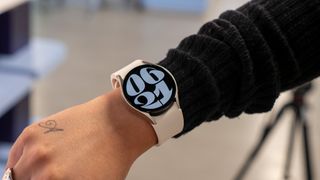
Whether you choose the Galaxy Watch 6 or Apple Watch Series 8, you get an ambient light sensor, accelerometer, barometer/altimeter, electrical heart sensor (ECG), gyroscope, optical heart rate sensor (HRM), pulse oximeter (SpO2), and temperature sensor.
All largely have the same functions, and both brands have well-earned reputations for pretty solid accuracy for health data. Samsung also caught up to Apple in two key areas with the Galaxy Watch 6: it finally activated its temperature sensor for menstrual tracking and sleep data and enabled passive heart rate rhythm monitoring to check for arrhythmia.
Samsung's only exclusive feature is its Bioelectrical Impedance Analysis sensor that detects your skeletal muscle, basal metabolic rate, and body water/ fat percentage. While serious health nuts will appreciate the addition, we've found that the results aren't always in line with what a smart scale will tell you. Take your results with a grain of salt.
Samsung Galaxy Watch 6 vs. Apple Watch Series 8: Software
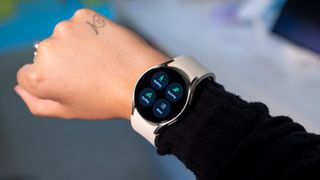
The Galaxy Watch 6 runs One UI 5 Watch based on Wear OS 4, while the Apple Watch Series 8 launched with watchOS 9 and will jump to watchOS 10 soon. Samsung will likely give its newest watch four years of software updates, while Apple typically offers at least five years of support for its watches.
Whether you look at the best Wear OS apps or the best Apple Watch apps, you'll find plenty of high-quality third-party apps. Because Apple Watches are higher selling, developers sometimes prioritize new features on watchOS first before bringing them to Android; but Wear OS has gotten a lot better for software support now that its user base has grown in recent years.
With either Samsung Health and Apple Health, you get all the fitness essentials like daily goals for steps and activity, personalized heart rate zones for running (and cycling on the Apple Watch) to judge your effort level, and all the main sports modes for tracking activities. Each app also shows data on your sleep quality, past workouts, and more.
If you're willing to pay for Apple Fitness+, you'll get tons of professionally guided at-home workouts in common categories like HIIT and strength. Samsung Health has a few guided programs for free, but nothing at the level of what Apple offers in its subscription.
Both watches come with Bluetooth 5.3, basic Wi-Fi connectivity for downloads, NFC for mobile payments with their respective Wallet apps, all the main satellite standards like GPS, and an optional upgrade to LTE with all the usual carriers.
Apple has one upside here: an Ultra Wideband chip, which makes it easier to track down a missing watch using the Find My app. Plus, it makes the Apple Watch potentially work as a digital car key.
Which should you buy?
The Apple Watch Series 8 starts at $399, the same price as the Galaxy Watch 6 Classic. For the base Galaxy Watch 6, you'll pay a mere $299 — slightly higher than the Watch 5, but still a deal compared to what Apple charges. Both Apple and Samsung charge $30 to upgrade to the larger versions of their respective watches.
As we said before, you should buy whichever watch goes with your chosen ecosystem. Apple users really don't have much choice since no other watches get system access to their iPhones to make them really effective.
Android users have more to consider. The best Android watches from Google, Mobvoi, Fossil, and various fitness brands all give you intriguing options. And a couple of Galaxy Watch 6 features are exclusive to Samsung phones, meaning people who own great Android phones from other brands may miss out.
The best competitor to the Galaxy Watch 6 may be Samsung's other watches. Our Galaxy Watch 6 vs. 5 guide shows that the last-gen watch still has its upsides if you can buy one for an affordable price; or, if you're willing to pay extra, the Classic solves the control issues that come with the Watch 6's capacitive touch bezel.
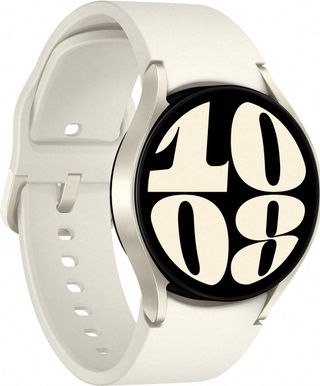
Choose the Galaxy Watch 6 for a durable, fast, and decently long-lasting smartwatch for a respectable price. Don't choose it if you're frustrated by touch controls or are considering switching to iOS.

Choose the Apple Watch Series 8 if you're a loyal iPhone user who can't stand the wait until the Series 9 launches later this year. Don't buy it if you want a watch that lasts at least a full day, or if you're considering switching to Android.
Be an expert in 5 minutes
Get the latest news from Android Central, your trusted companion in the world of Android

Michael is Android Central's resident expert on fitness tech and wearables, with an enthusiast's love of VR tech on the side. After years freelancing for Techradar, Wareable, Windows Central, Digital Trends, and other sites on a variety of tech topics, AC has given him the chance to really dive into the topics he's passionate about. He's also a semi-reformed Apple-to-Android user who loves D&D, Star Wars, and Lord of the Rings.
For wearables, Michael has tested dozens of smartwatches from Garmin, Fitbit, Samsung, Apple, COROS, Polar, Amazfit, and other brands, and will always focus on recommending the best product over the best brand. He's also completed marathons like NYC, SF, Marine Corps, Big Sur, and California International — though he's still trying to break that 4-hour barrier.
